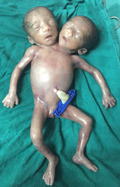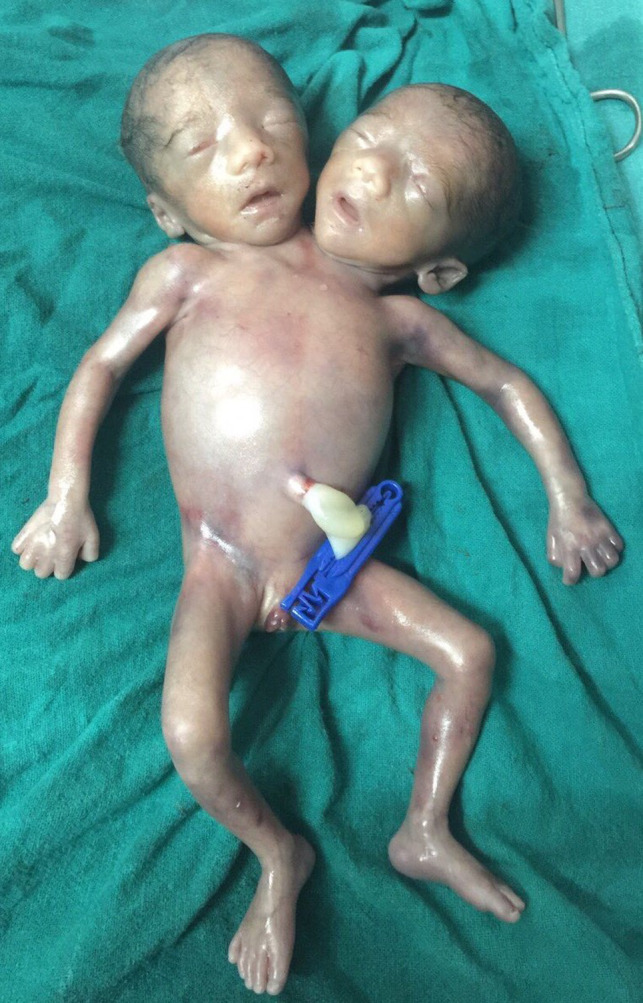Abstract
Dicephalus parapagus are conjoined twins with two separate heads. Proper identification helps in patient counseling and timely referral to specialist centers.
Keywords: clinical image, conjoined twins, dicephalus parapagus, monoamniotic twins
Dicephalus parapagus are conjoined twins with two separate heads. Proper identification helps in patient counseling and timely referral to specialist centers.

1. CASE PRESENTATION
A 22‐year‐old primigravida presented to us at 34 weeks of gestation. She had not had any previous antenatal visits owing to financial constraints and geographical inaccessibility. Past medical and surgical history were nonsignificant. Ultrasonography at our center revealed findings suggestive of monochorionic‐monoamniotic conjoined twin pregnancy, and cesarean delivery was subsequently planned. A 2.1 kilograms, still‐born, conjoined female twin was delivered (Figure 1). The twins had a single torso and umbilicus, two heads, two upper limbs, and two lower limbs. Computed tomography of the twins revealed two vertebral columns and a single pelvis with unitary lower gastrointestinal tract. A diagnosis of dicephalus parapagus conjoined twins was made.
FIGURE 1.

Photograph showing a conjoined twin with two heads, two upper limbs, and two lower limbs—the dicephalus parapagus twins
2. DISCUSSION
Conjoined twins are rare type of monoamniotic twins, with global incidence estimated at 1.5 per 100,000 births.1 These are further classified based on site of fusion‐ parapagus being the commonest subtype.2 Parapagus is when the line of fusion extends caudally from lower abdomen to pelvis on the ventral side. Dicephalus parapagus are the parapagus twins with two separate heads. These are rarely encountered in clinical practice and have poor prognosis. Timely diagnosis is important since specialized care may increase chances of survival in some cases.
CONFLICTS OF INTEREST
None.
AUTHOR CONTRIBUTIONS
MK, AB, and CP involved in conceptualization. MK, BM, PS, AB, SY, and CP involved in design, literature review, and write‐up. MK, BM, PS, AB, SY, and CP seen and approved the final manuscript.
CONSENT FOR PUBLICATION
Written informed consent was obtained from the patient for publication of this case report and any accompanying images.
ACKNOWLEDGEMENTS
None.
Karn M, Mahato B, Sah P, Basnet A, Yonghang S, Pandit C. Dicephalus parapagus conjoined twins. Clin Case Rep. 2021;9:e04663. 10.1002/ccr3.4663
Paper presentation information: This case was presented as a poster at the 15th International Conference of the Nepal Society of Obstetricians and Gynaecologist (NESOG) at Kathmandu, Nepal held from April 2–3, 2021.
Funding information
None
DATA AVAILABILITY STATEMENT
The data that support the findings of this study are available on request from the corresponding author. The data are not publicly available due to privacy or ethical restrictions.
REFERENCES
- 1.Mutchinick OM, Luna‐Muñoz L, Amar E, et al. Conjoined twins: a worldwide collaborative epidemiological study of the International Clearinghouse for Birth Defects Surveillance and Research. Am J Med Genet Part C Semin Med Genet. 2011;157(4):274‐287. 10.1002/ajmg.c.30321 [DOI] [PMC free article] [PubMed] [Google Scholar]
- 2.Baken L, Rousian M, Kompanje EJO, et al. Diagnostic techniques and criteria for first‐trimester conjoined twin documentation: a review of the literature illustrated by three recent cases. Obstet Gynecol Surv. 2013;68(11):743‐752. 10.1097/OGX.0000000000000000 [DOI] [PubMed] [Google Scholar]
Associated Data
This section collects any data citations, data availability statements, or supplementary materials included in this article.
Data Availability Statement
The data that support the findings of this study are available on request from the corresponding author. The data are not publicly available due to privacy or ethical restrictions.


